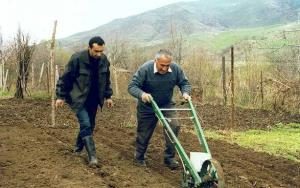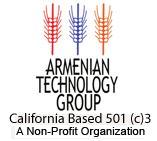Tegh -- "Without a Plow, What Would the World Be?"
| April 7, 2006
For additional photos related to this article, visit the ATG Photo Gallery.  Yerevan, Armenia — On a cool, early spring morning in Tegh, a village near Goris in southern Armenia, agronomist Vaghinak Kamrastyan held one of many tree cuttings and carefully trimmed its root system, then moved on to the next. A strong wind stirred, typical for the time of the year. “These trees are a new variety of apple, just now being tried in Armenia,” Kamrastyan said. “I’ll plant them in the garden next to my house in Oshakan, so I can watch their progress more closely.” Kamrastyan and fellow-agronomist Gagik Mkrtchyan, who work for the California-based Armenian Technology Group (ATG), gathered the cuttings and left for a field near Tegh. There, they would plant small experimental plots of several varieties of chickpeas, lentils, and peas, as part of a new program initiated by ATG. “I have worked for ATG since 1994,” Kamrastyan said. “Back then, we introduced new varieties of wheat, barley, and alfalfa to Armenian farmers at a time when those being planted had become several years removed from the Mother Seed, and were infected. Now, over 10 years later, we are continuing what we started during those difficult years.” Upon reaching the field, Kamrastyan began preparing the soil with a rake for the experimental planting, smoothing the ground and then forming small banks around each individual plot. Mkrtchyan brought the first variety of chickpeas to plant, offered by Garnik Petrosyan of the Armenian Agriculture Ministry. “When Garnik found out what we were doing, he said he had several varieties of chickpeas and sunflower seeds for us to plant, so the ministry would know what varieties had a future in Armenia,” Kamrastyan said. “ATG has always maintained good working relations with the ministry, and other organizations, over the years.” Kamrastyan and Mkrtchyan, along with area farmers Samuel Davtyan and Rubik Sardaryan, set the planter at the proper seeding rate. Mkrtchyan filled the planter with “Evans” chickpeas. As the men worked, several women cleared an area of Davtyan’s nursery where fruit trees would be planted. Beyond the nursery, a small gorge separates Tegh from the village of Khundzoresk. To the east, overlooking newly sprouted wheat fields and rolling hills, is the town of Lachin. “It is important to keep these border areas strong,” Kamrastyan said. “At ATG, we concentrate our efforts on border regions. In the end, the nation’s security depends on the strength of these regions.” Since 2004, Kamrastyan has worked for the ATG-created Seed Producers Support Association (SPSA), for which Mkrtchyan serves as executive director. The agency strives to strengthen Armenia’s agricultural base by providing access to the best varieties of wheat and barley, experimenting with new varieties while guaranteeing farmers access to high quality seed. “This program is a natural continuation of ATG’s Wheat Seed Project, which we launched in 1994,” Kamrastyan explained. “In the past two years, we have formed a network of farmers across the country, who provide land for seed multiplication and offer good seed to farmers at a fair price. We continually strive to provide the best varieties, setting up experimental plots in each of Armenia’s varied climates and landscapes. We even plant at altitudes over 2,000 meters, and have found varieties successful at that altitude. “Our work is very precise,” he continued. “We keep records of every variety, at each experimental plot, and offer this information to our farmers, who can then choose the variety suited to their region. I personally keep track of our transactions with individual farmers and village organizations. Before working for ATG, I was the government’s chief agronomist for the region around Ashtarak. Besides taking care of area agriculture, we did accounting and bookkeeping for the ministry. Now, this experience is helping us maintain the highest professional standards for SPSA.” Call of the blood Storm clouds gathered above the hilly fields surrounding Tegh. The men rushed to plant the last two plots of lentils and peas. Kamrastyan checked the soil moisture as he raked the ground. “Conditions are perfect after last week’s rain,” he said. “Now, if rain comes, the seeds will sprout well, and we’ll be able to see which varieties have a future here.” Kamrastyan walked behind the planter towards the end of the small plot. “We will come back to Tegh later this spring to check the plots,” he said. “This is an important project. Farmers and ministry officials are watching. Even President Kocharian knows about what we are doing, and has talked about how Armenian agriculture could benefit. “ATG was among the first organizations from outside the country to start programs for our farmers,” he said. “Working for ATG, I have made friends all over the republic. Together, we work the land, for the good of the country. My own ancestors were farmers, going back over 200 years. They planted vineyards in Oshakan that are still known by their last name. A tie to the past is important to me, as it is to all Armenians. I want to start my own vineyard in Oshakan. I can’t picture the world without farming, without watching things grow. I have no patience for people who don’t take their work seriously, and who don’t work honestly. “I love my country, and its traditions. I love my village, and the street leading to our house. I love my family. And, I love my work. Without a plow, what would the world be?” For more information about how you can help Armenia’s farmers, contact the ATG office at (559) 224-1000 or by e-mail (info@atgusa.org). Tax-deductible donations can be sent to ATG; 1300 E. Shaw, Suite 149; P.O.Box 5969; Fresno, CA 93755-5969. |

Follow Us